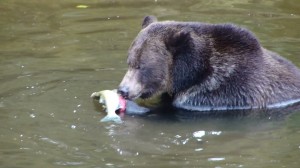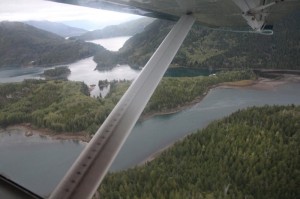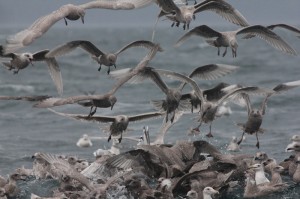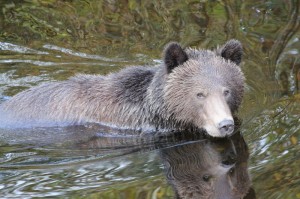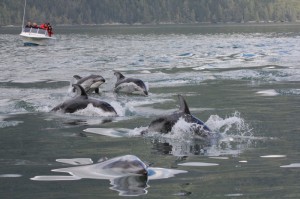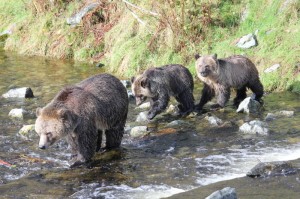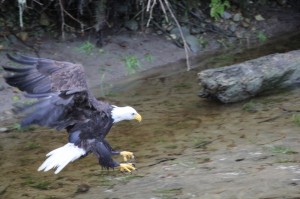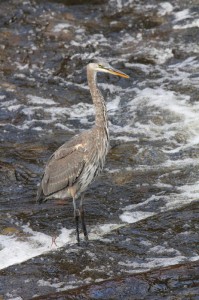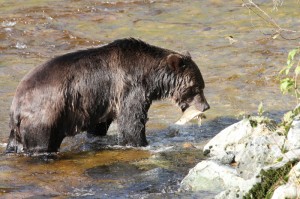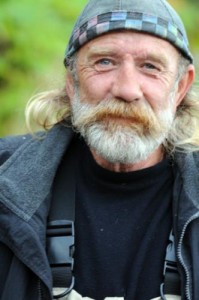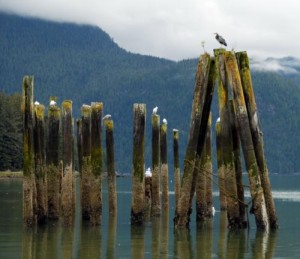Luwen & Liwen from Singapore got a great picture of a grizzly bear on the Glendale River in Knight Inlet eating one of the favourite parts of a salmon it just caught: the eggs or roe. During the peak of the salmon run the bears have access to an abundance of salmon at that time they will eat only the parts highest in calories – the eggs, skin and brains. Salmon roe and skin are also high in fat; grizzlies will often discard the body of the fish, which is left for the eagles. Early is the salmon run the grizzly devour the whole fish to “bulk up” for the coming winter this is also true later in the season for those bears that have not achieved sufficient weight or fat to survive the winter.
All posts by Lodge Guide
Pictures that interest Grizzly Bear Lodge’s guests
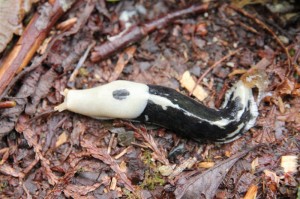 Grizzly Bear Lodge is a remote lodge meaning arrival is by floatplane from Campbell River on Vancouver Island. This is another great photo opportunity as shown by this picture from guest James O’Donoghue. The forty-five minute flight passes over the mostly uninhabited coast except for the fish farm and logging camps. According to the website “Creation Wiki”: “The Banana slug is the 2nd largest slug in the world – the largest in North America. Banana slugs can grow all the way up to 25cm (10inches) in length.” The lodge is located in the southern portion of BC’s the Great Bear Rainforest and a rainforest does encourage everything to grow “big”.
Grizzly Bear Lodge is a remote lodge meaning arrival is by floatplane from Campbell River on Vancouver Island. This is another great photo opportunity as shown by this picture from guest James O’Donoghue. The forty-five minute flight passes over the mostly uninhabited coast except for the fish farm and logging camps. According to the website “Creation Wiki”: “The Banana slug is the 2nd largest slug in the world – the largest in North America. Banana slugs can grow all the way up to 25cm (10inches) in length.” The lodge is located in the southern portion of BC’s the Great Bear Rainforest and a rainforest does encourage everything to grow “big”.
Whale Watching while seagulls feed
A herring “ball” results when a school of herring is chased to the surface by a predatory fish, ducks or other diving birds. Often the herring balls can be spotted by a large flock of seagulls noisily feeding on the surface. Spotting the gulls feeding is a joy for your guide as the unenviable fate of the herring is to be dinner for a larger mammal meaning humpback whales. As a guide once the herring ball is located the intent is to stop the boat in proximity of the gulls and wait. “Keep your eye on the gulls and as they lift into the air get ready for a picture of a whale lunge feeding”(see tomorrow’s blog) is the directions given to the guests while we wait. James O’Donoghue’s photo captured the mass of the gulls but not the noise they produce. The area for the lodge’s whale watching safari day is Blackfish Sound not far from Vancouver Island’s Telegraph Cove. It is an area known for the abundance of herring and thus popular for salmon fishing which also means orca that feed on the salmon.
“Caught in the act” by a Grizzly Bear
Just when you think the grizzly bears you are viewing do not really know that you are there you get one that looks you right in the eye when caught taking a photo. To put a human touch it would be “A little privacy if you don’t mind.” The bears on the lodge’s tour up Knight Inlet tend to ignore our intrusion into their life. In the spring and summer, while they are feeding on the beach they only acknowledge our presence if we get to close. In the fall in the viewing stands on the Glendale River sudden movement, load noises or a cameras flash left on will get their attention. For the most part the grizzly is aware but chooses to ignore. Guest James O’Donoghue from the UK provided this photo.
Whale Watching and Pacific White-side Dolphins
I cannot think of another photo that I have posted of white-sided dolphins, which tells a more complete story than this one from James O’Donoghue. On tour days we frequently travel with another boat from the lodge when we run to Johnstone Strait near Telegraph Cove to look for whales thus the picture of one of our boats in the back ground. Notice the warm “floater” suits the guests wear while on the water. Even though this is summer it is cool on the water in the morning. Also it is easy to pick out the guide without the suit as we tend to be climatized to the weather. The most amazing aspect of the photo is the fact that it shows every stage of white sides’ “porpoise” (short term for the way dolphins come out of the water when traveling in a hurry). It shows them first breaking out of the water to clearing the water and then their returning dive. Also note the calm water surrounding the ripples indicating there are likely several hundred dolphins keeping the water churned up as they pass close to our boat.
Grizzly Bear with two two-year old cubs
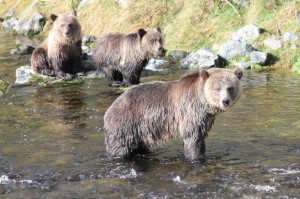 The abundance of salmon in the Glendale River means the grizzly bears are not very aggressive and tend to be more tolerant of each other. This makes for a safer location for mothers to bring their cubs to learn to fish for salmon. The first photo provide by James O’Donoghue shows a mother leading her two cubs into the fishing area and by their size these cubs would be in their second summer with mom. It is time to learn to catch salmon as it could be their last year before they are on their own although some cubs do spend a third season with mom. If you check out the waters around the bears there are not many salmon in the river so it must be early in the season this means today’s lesson may be one in patience.
The abundance of salmon in the Glendale River means the grizzly bears are not very aggressive and tend to be more tolerant of each other. This makes for a safer location for mothers to bring their cubs to learn to fish for salmon. The first photo provide by James O’Donoghue shows a mother leading her two cubs into the fishing area and by their size these cubs would be in their second summer with mom. It is time to learn to catch salmon as it could be their last year before they are on their own although some cubs do spend a third season with mom. If you check out the waters around the bears there are not many salmon in the river so it must be early in the season this means today’s lesson may be one in patience.
Eagle salmon fishing with the grizzly bears
Excellent photos from UK’s James O’Donoghue. While in the viewing stands on the Glendale River there is always activity if you tire to the bears take time for some eagle action or blue herons. The grizzly bears are constantly leaving partially eaten salmon on the shore, which makes the eagles life much easier while the heron are searching for small trout. This eagle appears to be coming to claim some prey either a fresh salmon on a carcass. If you check the feathers above the talons they are wet making me think that a water catch was missed. In the fall the eagle move from other areas along the British Columbia coast to the river where the is much more food and thus providing or guest with great opportunities for photo like this one.
Grizzly Bears and deep water salmon fishing
The area Grizzly Bear Lodge uses for viewing bears in the fall is on Knight Inlet’s Glendale River. The viewing stands are a fifteen minute van ride up the river and are located right on the river a few meters (yards) from the waters edge. Some parts of the viewing area are in shallow water where the bears are seen chasing the salmon and catching them on the surface. This takes quite a bit of energy and time as the fish are fast. Other bears prefer to conserve their energy and fish in the deep water, which requires bears to dive to pick up dead or wounded salmon that have drift down from up stream. When deep water fishing it is often easier to walk to shore to eat than constantly diving to retrieve the dropped meat. James O’Donoghue of the UK provided this photo.
The extra day and memories with“The Trapper”
If stay the extra night at our lodge the extra day is a river day spent at a “wild” river on a wilderness tour. Crossing Knight Inlet we travel the length of Thompson Sound to the Kakweikan River and spend a day with The Trapper. Rick has spent a good part of his life on this river and protects it with a passion. Grizzly Bear Lodge is the only lodge in the area with access to this river. The scenery on this part of BC’s mainland in breathtaking and the wildlife viewing provides a reasonable chance of grizzly bear sightings. Bears are often seen below the falls at Rick’s cabin or on the road to the cabin. Seeing a grizzly bear at Rick’s is a different sensation than see one from a protected viewing stand on Knight Inlet’s Glendale River. Maybe that is why Rick always has “Rosemarie” with him. Who is “Rosemarie” that you will have to ask Rick?
Glendale River Knight Inlet BC
This is a scene of peace and serenity, the was picture taken by guest Debbie Zygmunt from the dock in the estuary of the Glendale River on Knight Inlet. The grizzly bear tours leaving Grizzly Bear Lodge travel for about an hour up Knight Inlet to the Glendale. We spend the morning and part of the afternoon viewing grizzly bears in the estuary in the spring or on the river in the fall after the pink salmon have arrived. A picnic lunch is served on the dock each tour at mid day. The pilings in the picture are located near the end of the dock supported the original landing for a logging camp the was on the shore up until the nineteen fifties. The shore opposite the dock has similar pilings from a salmon cannery that operated in the nineteen twenties.
